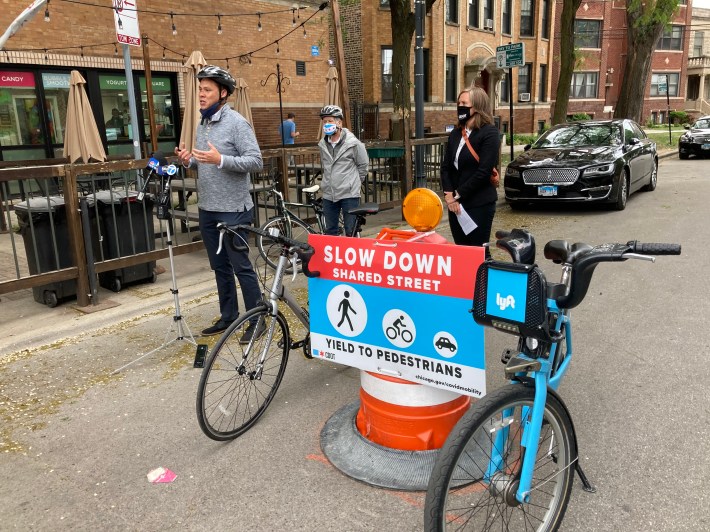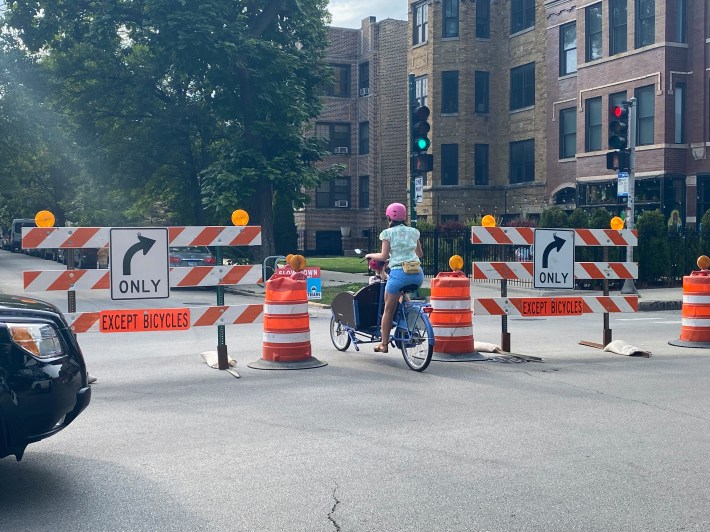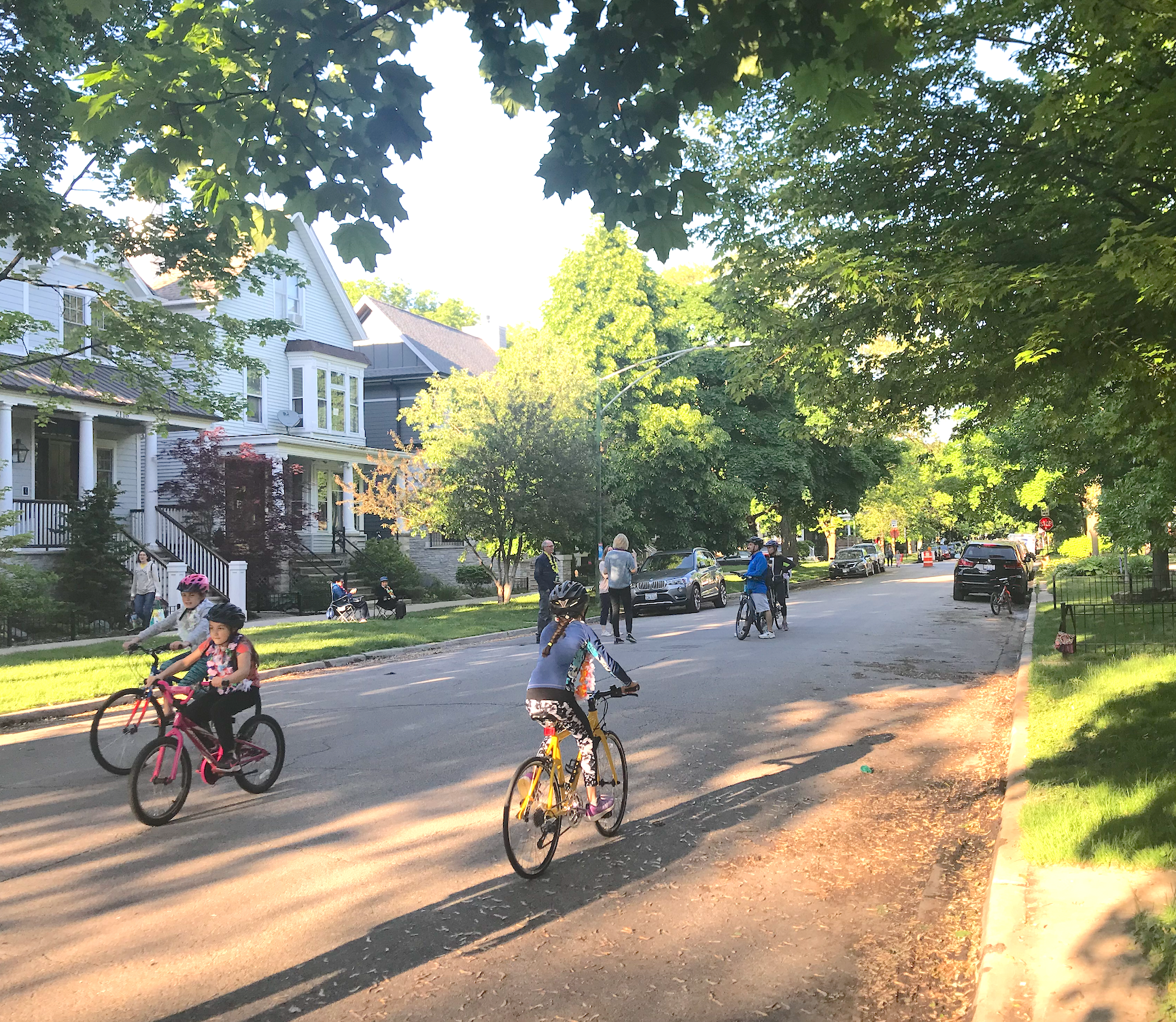Update 9/10/21, 3:15 PM: 46th Ward chief of staff Tressa Feher confirmed that the Leland Slow Street was taken down early due to feedback from residents. "We got a lot more complaints this year. Last year everyone was stuck at home, but this year there was less use. The hardware, the barrels and barricades, was too much, causing drivers to swerve straight into the paths of bicyclists."
Feher added that comments on a community survey and on Facebook indicated that "people really like the idea of slowing [drivers] down, but there were problems with drivers not knowing where to go and the barrels getting moved around. We want to talk to CDOT about other ways to calm traffic. If we can get better, more permanent infrastructure, I think people would really like that."
Last year during the thick of the COVID-19 pandemic, the wildly popular Leland Avenue Slow Street treatment (the city calls it a "Shared Street") in Lincoln Square, Ravenswood, and Uptown stayed up until late November, when it was dismantled in preparation for snow-plowing season.
All right, time to go enjoy the last hour of daylight on the Leland Slow Street before @ChicagoDOT dismantles it in time for snow plow season...https://t.co/eP0T8D6jyb pic.twitter.com/UnBSfxBOBY
— John Greenfield (@greenfieldjohn) November 28, 2020
Disappointingly, this year all of the traffic barrels and barricades were removed right after Labor Day, about three months earlier than last year. That's despite the fact that it's currently absolutely perfect for walking, jogging, and biking on streets where active transportation and recreation is made safer by banning motorized through traffic.
When the Leland Slow Street was reopened in late May of this year, local aldermen James Cappleman (46th) and Matt Martin (47th) noted that the low-stress corridor was a great community resource. "We’re delighted to have [the Slow Street], our residents love it," Cappleman said at the reopening celebration. "And I welcome everyone to, please, please, don’t get in your car, ride your bike.”
“We’re really happy to be opening up our [Slow Street] for the second year in a row,” Martin said at the event. “We knew during the pandemic that people needed more outdoor spaces to be able to congregate and see one another in a safe way as well as exercise. Even with us getting a good handle on the pandemic, what we heard from folks is that they love this as an opportunity to be able to walk, bike, run, be outdoors, use streets in a safe and really really enjoyable way.”

Martin broke the bad news about this year's early closure in a message to constituents. "With summer vacation ending, [the Chicago Department of Transportation] will be ending the Leland Shared Street between Lincoln Ave. and Sheridan Rd., removing barrels and barricades after Labor Day weekend," the alderman said. "The Shared Street program has provided pedestrians with more space to walk and run in a street with limited and calmed car traffic."
Martin added that CDOT measured a 350 percent increase in foot traffic traffic during the 2020 Slow Street pilot. "This year, however, did not see as significant a use by pedestrians – likely due to the end of the Stay At Home order and the reopening of the lakefront, parks, and playgrounds. As such, CDOT and Alds. Martin and Cappleman have determined that the end of the summer vacation was an appropriate time to end this pilot." It's safe to assume that the decision to remove the Slow Street prematurely was largely due to complaints from motorists who were annoyed at having to change their driving habits.
Despite the lower pedestrian use this year, the Slow Street still have major benefits, Martin said. "According to data provided by CDOT, traffic calming measures caused a more than 50 percent decrease in car traffic on Leland Ave. This, in turn, led to an 85 percent increase in the number of cyclists using the street – data which align with positive feedback our office received from cyclists, including less experienced riders." So if the Slow Street treatment was still very successful in encouraging biking, why did it make sense to take it down during peak cycling season?
Martin noted that these findings show that there's a latent demand for traffic calming in other parts of the ward to encourage cycling, including the use of traffic diverters to physically prevent, not just discourage, drivers from using residential streets as cut-through routes. Temporary traffic diverters are currently being tested on the service drives of Logan Boulevard at California and Sacramento avenues in Logan Square as part of a Slow Street treatment on Logan, as well as Kedzie Boulevard.

Martin also noted that the permanent Leland Neighborhood Greenway will be installed between the Chicago River and Clark Street next year. (It was originally supposed to be put in this year.) That facility will include contraflow bike lanes that will allow cycling in both directions, plus sidewalk bump-outs to shorten crossing distances, bike-friendly speed bumps, and raised crosswalks.
According to CDOT spokesperson Mike Claffey, in addition to Logan/Kedzie, Slow Streets are slated to be in place through the end of November on South Shore Drive, Dante Avenue/77th Street, and Seminary Avenue.




